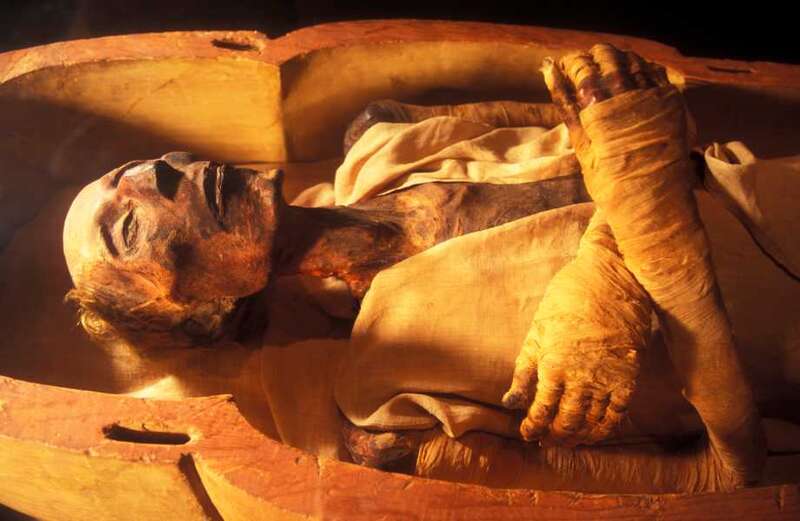THE resting place of Egypt’s most powerful pharaoh has been discovered 3,000 years after his death in a secret tomb underneath a monastery.
The resting place of Ramesses II was revealed by archaeologists when they examined a mysterious granite burial tomb found under the floor of a religious centre in east-central Egypt.



Known as Ramesses the Great, the pharaoh reigned from 1279 to 1213BC.
Huge statues and buildings constructed in his honour marked the last peak of Egypt’s power.
The remains of a high priest were originally found in the sarcophagus but the latest discovery indicates he removed the pharaohs mummy and coffin to reuse.
 London, New York and Europe welcome New Year; plus pics from around the world
London, New York and Europe welcome New Year; plus pics from around the world
Egyptologist Frédéric Payraudeau, a teacher and researcher at the Sorbonne University in Paris, made the discovery last month after re-examining a fragment of granite discovered in Abydos back in 2009.
The stone, measuring five feet long and three inches thick, was found to have a previously overlooked engraving that read “of Ramesses II himself,” according to a translated statement from France’s National Centre for Scientific Research.
Payraudeau said: “When I read these results, I was overcome with doubt.
“I asked my American colleague if I could re-study the file, which he accepted given the complexity of this case.
“My colleagues believed that the cartouche preceded by the word 'king' designated the high priest Menkheperre who governed southern Egypt around 1000 BC.
“However, this cartridge actually dated from the previous engraving and therefore designated its first owner.”
He explained that engravings of the Book of Doors, an initiatory story reserved for kings during the time of the Ramesses, was also featured on the sarcophagus.
Payraudeau said: “The royal cartouche contains the coronation name of Ramesses II, which is specific to him, but this was masked by the condition of the stone and by a second engraving, added during the reuse.”
Archaeologists had previously established that Ramesses II was buried in a golden coffin which was stolen in Antiquity an moved to an alabaster sarcophagus which was later destroyed.
 Messi has ‘verbal agreement’ to snub summer transfer and STAY at PSG
Messi has ‘verbal agreement’ to snub summer transfer and STAY at PSG
Those pieces were put in a large granite sarcophagus that was stolen for reuse by Menkheperrê some 200 years later.
Payraudeau said: “This discovery is new proof that at this time, the Valley of the Kings was the subject not only of looting but also of the reuse of funerary objects by subsequent sovereigns.”.
Ramesses II is widely considered to have been the most powerful and celebrated pharaoh in ancient Egypt.
He led several military expeditions and expanded the Egyptian empire from Syria in the east to Nubia in the south.
He was the third pharaoh of the 19th Dynasty of Egypt.
In 2022, scientists from Egypt and England recreated the pharaoh’s face using 3D modelling of his skull to rebuild his features.
It was the first “scientific facial reconstruction” of the pharaoh using a CT scan of his skull.
Cairo University’s Sahar Saleem, who created the model described Ramesses II as being a “very handsome” ruler.
He said: “My imagination of the face of Ramesses II was influenced by his mummy's face.
“However, the facial reconstruction helped to put a living face on the mummy.
“I find the reconstructed face is a very handsome Egyptian person with facial features characteristic of Ramesses II – the pronounced nose, and strong jaw.”
Caroline Wilkinson, director of the Face Lab at Liverpool John Moores University, which rebuilt the pharaoh's face, detailed the scientific process used in the reconstruction.
She said: “We take the computer tomography (CT) model of the skull, which gives us the 3D shape of the skull that we can take into our computer system.
“Then we have a database of pre-modelled facial anatomy that we import and then alter to fit the skull.
“So we're basically building the face, from the surface of the skull to the surface of the face, through the muscle structure, and the fat layers, and then finally the skin layer.”
She added: “We all have more or less the same muscles from the same origins with the same attachments.
“Because each of us has slightly different proportions and shape to our skull, you'll get slightly different shapes and proportions for muscles, and that will directly influence the shape of a face.”


































